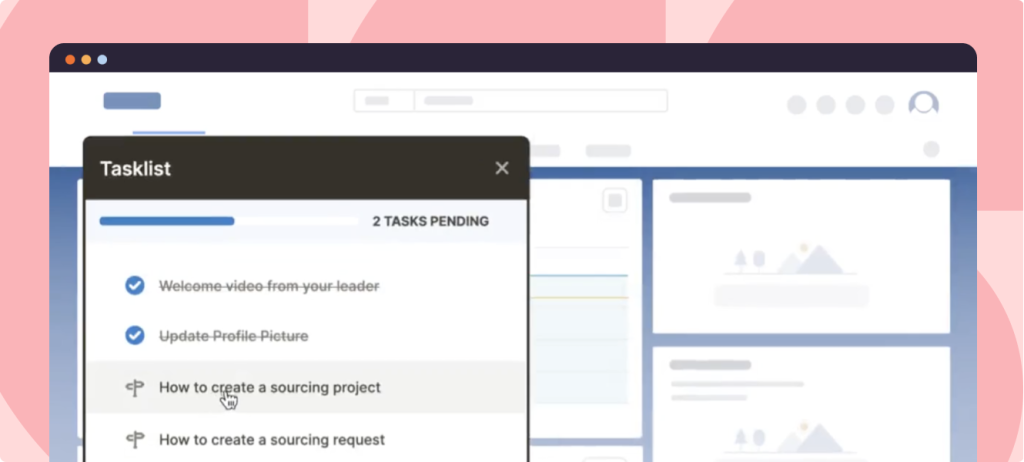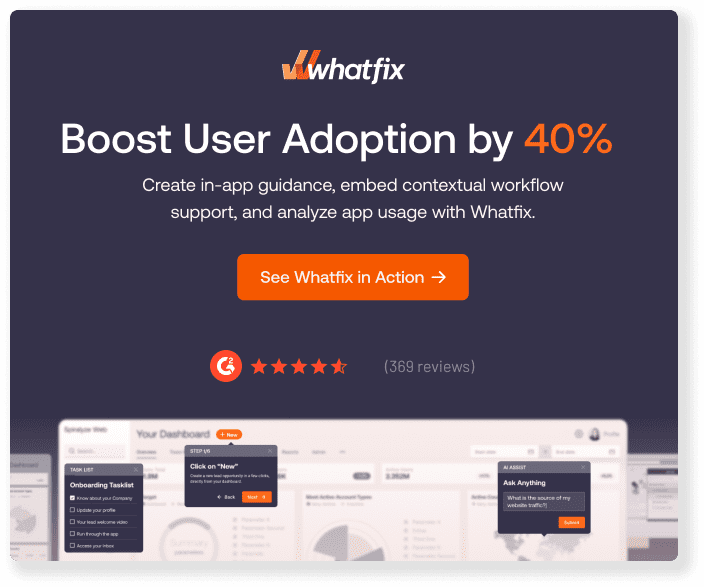When users sign up for a product or service, they want to realize value as quickly as possible.
There’s a direct connection between customer satisfaction levels and the time it takes for customers to see value in a product or service. McKinsey research revealed that banks reducing the time to value (TTV) for new account holders led to a customer satisfaction increase between 10% to 30%.
This metric is also significantly tied to revenue and business success, with an abundance of alternatives and competitors your customers can churn to – its critical to accelerate value realization from your customers as much as possible.
In this article, we’ll explore the time-to-value metric, types of TTV metrics, how to track it, and strategies to reduce it.
What Is Time to Value (TTV)?
Time to value (TTV) is a customer onboarding metric that measures the time it takes for new customers to realize value from a product or service after signing up.
The exact time to value depends on the complexity of your app, product, or service. Simply services or apps can be instantaneous (think of plagiarism checkers or Google Maps) while enterprise software can be months (like a CRM or ERP system.)
TTV is an important customer retention metric that helps companies make data-driven decisions to enable customers with product-led onboarding experiences and frictionless journeys that drive customer retention
TTV vs. “aha” moment
Time to value measures how quickly a customer realizes the benefits of a product or service. It’s the actual time from when a customer starts using the product or service to when they begin seeing measurable results and value.
The “aha” moment, on the other hand, is the exact moment when a customer has a sudden understanding of a product or service and realizes its potential. It’s a key point in the customer’s journey because it marks the point when they become a committed user or customer.
The Importance of Time to Value
Accelerating time-to-value for new customers and users provides benefits that improve customer lifecycle value and customer experience, and have a direct impact business revenue. Here are key benefits of reducing time to value:
- Higher customer satisfaction: Customers who realize value quickly from your product will build a solid first impression with your users and drive brand loyalty.
- Higher customer retention: Satisfied customers who drive ROI from your product or service will be less likely to switch to competitors.
- Faster account expansion: Customers who realize value quickly in your product will be more likely to renew, upgrade, or expand their account, driving revenue.
- Creates powers users: Customers who realize value early in their lifecycle will ve more likely to adopt advanced features and become product evangelists who use your app in unique ways.
- Competitive advantage: Products with fast time to value create a business moat that defends it from alternative products or services.
Types of Time to Value Metrics
Time to value (TTV) highly depends on the type of product or service you offer.
With that in mind, here are the five most common types of TTV metrics that companies track:
1. Time to basic value
Time to basic value is the shortest time-to-value metric. It is defined as when a customer realizes they made the correct choice in your product or service and begins to see real ROI and value from your offering. This can occur before a customer purchases a product via a free trial or demo.
Examples of time to basic value include:
- Canva: The time it takes a new Canva user to create their first graphic design.
- Asana: The time it takes a user to set up their first board.
- Fitness app: The time it takes to set up an account, input personal information, and start the first workout routine.
2. Time to exceed value
This TTV metric measures the time until a customer realizes the value of your product and your offering has exceeded their expectations. This can include a freemium user converting into a paid subscriber or larger upsell opportunities. The more a product or service can improve time to exceed value, the more it can increase customer lifetime value.
Examples of time to exceed value include:
- Canva: An example of time to exceed value would be a Canva user realizing it has more robust features than initially anticipated, which leads to the user converting into a paid Canva account to gain access to more advanced features. If this user is a graphic designer professional, this could even lead to an upsell for a Canva Business or Team account.
- Asana: The time from setup to the point where a team is now using advanced features like automation, reporting, and integrations to further drive team productivity (and thus value).
- Personal finance app: The time required to not only manage finances but also to use advanced analytics for strategic decision-making and growth planning.
3. Long time to value
This TTV metric is for products that may need to be implemented and learned over time, meaning it will take quite a long time for actual ROI, anywhere from weeks to months. Most SaaS products fall into this category.
Long time to value is incremental. Customer onboarding and success teams must dedicate time to their accounts to ensure proper training and setup. Be sure to highlight wins along the way so highlight to customers the more value they’re extracting from a product or service.
Examples of long time to value include:
- ERP system: ERPs are complex solutions that require months of setup, implementation, and end-user training to realize its full value and impact on streamlining operations, supply chain, finances, and procurement.
- CRM system: CRMs are also complex enterprise applications that take months to implement and start to extract value from its core features like customer relationship reporting, communication automation, and data integrations.
4. Short time to value
Short time to value refers to products or services that instantly solve a customer problem, usually within a day. While short time to value is easy to showcase, customers of these products and services have less patience for poor service and can easily churn to competitors who may offer lower prices or more value.
Examples of short time to value include:
- Consumer-based services like moving companies and carpet cleaners.
- Online banking: The time it takes to sign up and starting using an online banking account to pay bills and set up direct deposit.
- Freelance Platforms: The time it takes for freelancers to create a profile and start bidding on projects, often seeing results within days.
5. Immediate time to value
This is perhaps the easiest to understand of the TTV metrics. Immediate time to value is a metric for services that provide instant gratification and solutions to problems.
Examples of immediate time to value include:
- Online storage services like Google Drive or Box where a user signs up and instantly receives the ability to store, organize, and send files.
- Food delivery apps: New users download the app, place an order, and receive food within an hour.
- Streaming services: Users sign up for a service and instantly gain access to a library of movies and TV shows.
How to Measure Time-to-Value
While TTV is a relatively straightforward metrics, there are several strategies you can use to measure TTV. The most effective ones for your business will depend on the software you’re offering, your customer’s needs, and your specific business model.
You can follow the steps below to measure and track your time-to-value:
- Define what “value” is: The first step in measuring TTV is identifying the “value” of your product or service. This will be unique to every product and will require teams to conduct user research, collect feedback, and use analytics to define “value”. For SaaS products, it’s often creating your first project, completing their first task, or using a specific feature.
- Define the “start” point: Next, determine when you begin to measure TTV. This is dependent on the type of time-to-value metric you’re tracking and could be the moment a customer purchases a product, when they start onboarding, the first time a user logs into your product, etc.
- Define the “end” point: Determine the moment when a customer realizes “value”. This can be when a customer uses a particular feature or achieves a milestone.
- Measure the length of time: Calculate the length of time between the “start” and “end” points – this is your product’s time-to-value.
6 Ways to Reduce Time to Value
By accelerating value realization, customers are more likely to become activated and stick around – allowing product teams to overcome churn and retain users.
Here are six effective strategies to shorten time-to-value for new customers and users:
1. Guide users to value with product-led onboarding and in-app tutorials
Product teams can enable new customers with in-app guidance like product tours and new user checklists to guide them to their “aha!” moment. This gives users guardrails, providing them with clear objectives and progression as they familiarize themselves with your product.
Canva provides new users with product-led onboarding experiences to quickly drive value. Below you can see an example of Canva prompting users choose an in-app tutorial on how to select a template for their first project:
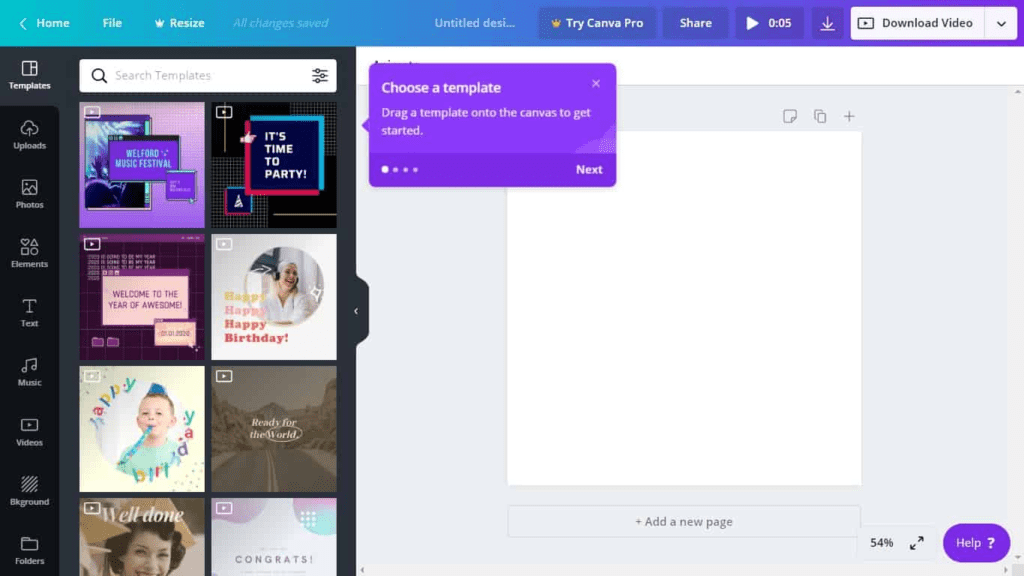
Another example is Box. Box has a quick time-to-value with a straightforward path for new users to follow. They guide them through this value realization process with an in-app checklist that guides them to upload their first file, create a new folder, share with team members, and download Box Drive’s app.
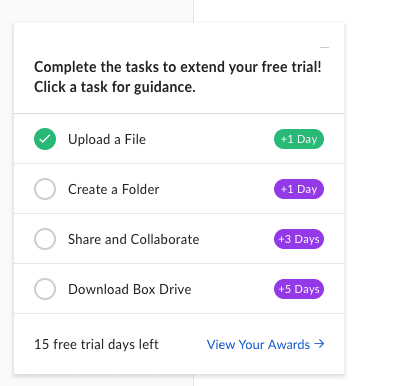
PRO TIP
With a digital adoption platform like Whatfix DAP, utilize a no-code editor to create, test, and launch in-app guided experiences like Tours, Task Lists, Flows, Smart Tips, and Pop-Ups without engineering dependencies.

2. Personalize the onboarding experience to individual customers and users
Most products have multiple use cases. Tailoring the new user onboarding experience to the needs of each use cases allows product teams to create contextual messaging and experiences that guide specific types of customers to realize value faster.
A simple way to achieve this is through welcome surveys. Welcome surveys are shown to new users shortly after signing up for a new product or logging in for the first time. They ask questions like “what’s your job function?”, “what’s your industry?”, and “what do you hope to achieve with our product?”, which allow product teams to then segment their onboarding experience by use case and uncover additional insights into their customers.
In the example below, Salesforce CRM uses a welcome survey to ask new customers what their highest priority is.
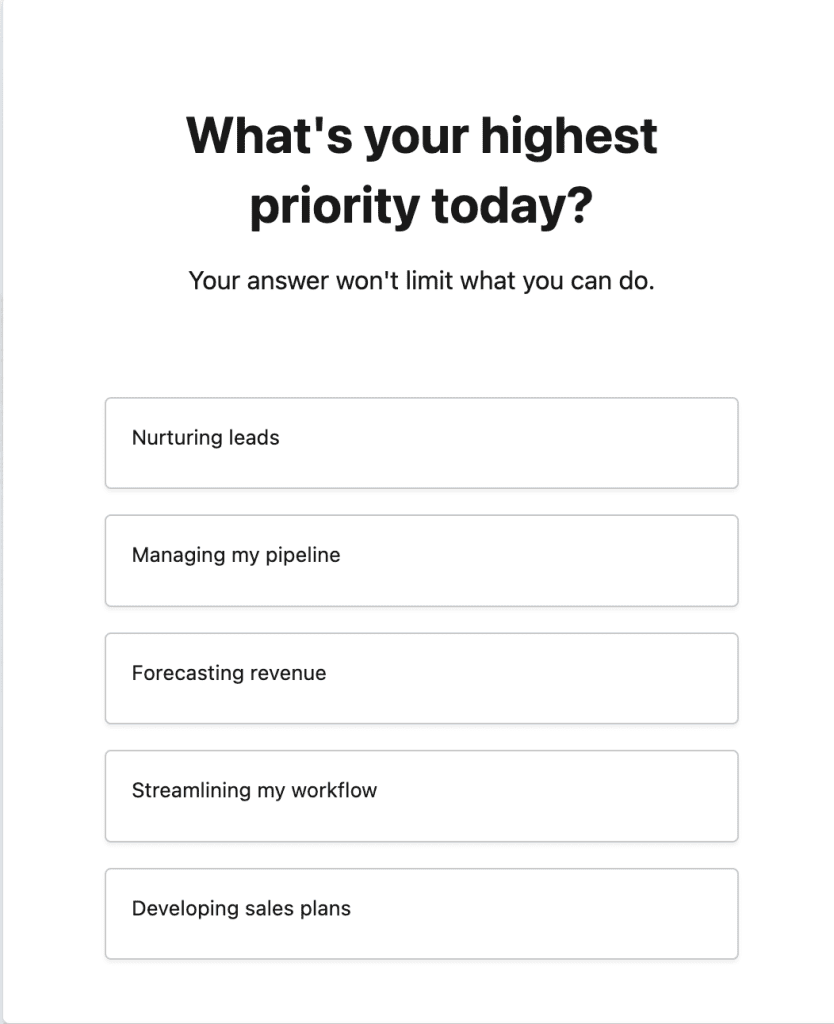
This allows Salesforce to trailor its user onboarding to focus on that specific priority using in-app tutorials that guide new users to complete that action – thus accelerating their time-to-value.
PRO TIP
With Whatfix DAP, create multi-path user onboarding experiences that are triggered based on user actions or events. Trigger specific in-app tutorials based on the type of user cohort a customer displays. Create and launch welcome surveys to further segment your new user onboarding experience.

3. Take a phased approach to driving adoption of advanced features
For more complex products, you must balance accelerating value realization while not overwhelming new users. Product teams can achieve this with a phased-approach to user onboarding.
Break your onboarding into three phases: primary user onboarding, secondary onboarding, and tertiary onboarding.
In the primary user onboarding phase, use traditional product tours to welcome new users to your product. Help users set up their profile, familiarize them with your product’s UI, guide them through your basic features, and get them started on their first task.
Secondary user onboarding is where you can begin to introduce more advanced features, taking them from initial value to comprehensive feature adoption and mastery of more complex tasks. This provides a more expansive realization of product value and an understanding of your product’s full potential.
In tertiary onboarding, utilize user signals to alert you of upsell and account expansion opportuinties. Use in-app tutorials to continue to drive value for your users on more advanced workflows or use Pop-Ups to alert users of new features and product updates. Utilize in-app surveys to collect feature requests to continue to build power users and brand evangelists.
PRO TIP
With Whatfix, enable product-led growth by upselling customers and driving account expansions with timely in-app messages and pop-ups. Create in-app surveys to understand each customer’s readiness to upgrade and use tools like pop-ups to create awareness and give each user personalized and relevant offers.
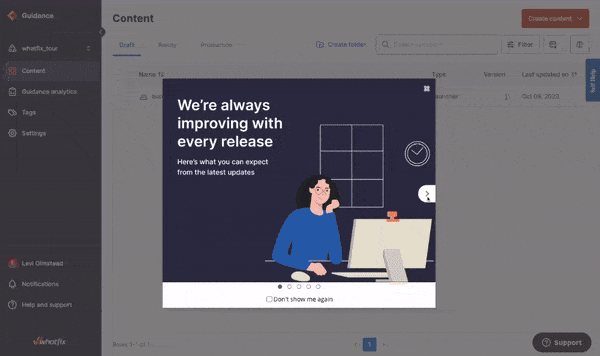
4. Hire customer success managers
Another way to acclerate time to value is to have a dedicated customer success manager (CSM) who is responsible specific accounts and helping them realize value.
A CSM acts as a point of contact for your customer. They help with implementation, answer support questions, providing 1-1 onboarding, and act as a dedicate resource to enable customers.
CSMs personalize the onboarding process by greeting customers by name in a welcome email and offering tailored recommendations and advice. Because answers and suggestions are personalized for the customer’s experience, they can clearly see the benefits of using your product. And the reduced time to value has a significant impact—almost one-third of surveyed companies said having dedicated customer success efforts resulted in a 20% or more rise in annual recurring revenue.
Proposify, a business proposal software, has a dedicated customer success team. Their CSMs act as inside advisers to their customers, showing them how Proposify’s software can solve their business problems. Managers even consult with the product team about what new features to add. They can then go back to the customer and show them a new feature added specifically to take care of a customer’s problem.
5. Identify and overcome areas of user friction slowing down value realization
Removing friction of your new user experiences is a tactile way to reduce time-to-value for new customers. User friction refers to any obstacle that stops users from completing a desired action inside your product and can manifest in many ways.
It’s usually caused by structural elements that affect your product’s usability, such as poor UI design choices, branding, technical resources, poor copy, convoluted user flows, product bugs, etc., and by the emotion your product triggers in users.
Product teams can use take a measured approach to identifying and addressing user friction through a series of actions, including:
- Conducting usability testing: Test your new user onboarding experience with a group of testers and have them complete a series of actions. This will highlight unforeseen issues or product bugs, providing insights into how new users will navigate your product, and track engagement with different UI elements and features within your product.
- Map your new user journey and flow: Take a step back and map your new user journey in a flow chart to visualize the steps required to achieve value. This will allow you to highlight redundant steps in the process, identify potential areas of dropoff, and optimize your new user experience.
- Conduct a funnel analysis. Your product team should know the “start” and “value realized” points for measuring time-to-value. Using a product analytics tool, create custom user actions for these two events and then conduct a funnel analysis to show you how many users made it across each step of your TTV funnel and where users are dropoff off. This will pinpoint the exact steps where new users are dropping off in their new user experience.
PRO TIP
With Whatfix Product Analytics, set up custom event tracking to measure user behavior and product usage without technical dependencies. Use Funnels and Journeys to understand how users are moving through your product and where they’re experiencing friction. Create Cohorts to compare different segments of users against one another. Track any user action and take a data-driven approach to UX improvement with Whatfix PA.

6. Provide self-help support
Customers expect frictionless support experiences. That means enabling them with in-app support and customer self-service like knowledge bases and community forums where they can answer questions without requesting additional help from support teams.
For example, Sophos Firewall requires a complex technical setup to get its customers up and running. Sophos’s challenge was to guide users through the complexities of its Firewall configuration, deployment, and maintenance.
Accurate configuration was vital, as adversaries only needed to be lucky once to bypass a customer’s firewall and gain access to sensitive data, networks, and devices. Many customers relied on Sophos’ technical support, as they lacked the expertise and engineering resources of a dedicated in-house security operations center to manage the firewall implementation.
With Whatfix, Sophos provided in-app guidance and contextual self-support to thousands of Sophos Firewall customers, with “Sophos Assistant” that provided a self-help overlay on its web admin console UI. Step-by-step instructions (Flows), pop-ups, and a self-help knowledge repository were integrated inside Firewall’s UI, with approximately 700 links to Sophos Firewall-related help and support content.
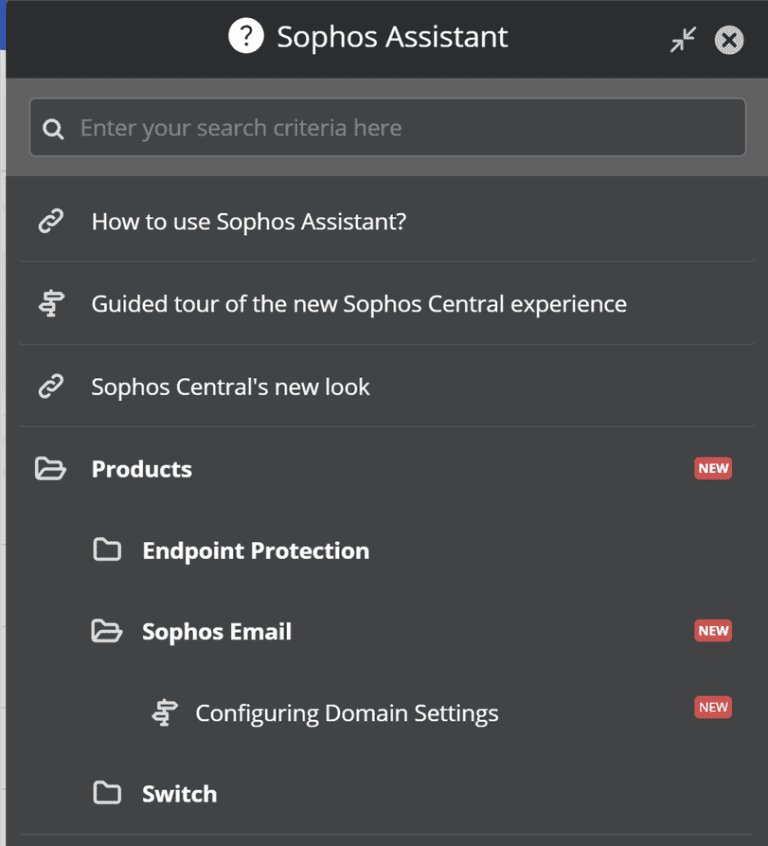
Last year alone, over 50,000 in-app Flows were played, and support documentation was referred to 34,000+ times. A Sophos customer survey discovered that 87% of its Firewall users found the in-app guided Flows helpful.
PRO TIP
With Whatfix Self Help, enable users with an in-app resource center that integrates with your knowledge base, FAQs, video tutorials, and customer training resources. Customers can search for any contextual issue they’re facing with Self Help’s searchbar and its GenAI-powered conversational bot can providing personalized answers and recommendations. Users can also prompt in-app tutorials from Self Help.

Adoption Clicks Better With Whatfix
For smaller product teams and non-technical product managers tasked with owning a user onboarding strategy and launching in-app guidance, a DAP like Whatfix empowers them to analyze, build, and deliver contextual new user onboarding experiences that drive adoption and accelerate time-to-value.
1. Create personalized user onboarding and in-app tutorials with a no-code editor
With Whatfix DAP, use a no-code editor to quickly create new in-app guided experiences that match your app’s branding.
From Tours, Task Lists, Flows, Pop-Ups, Smart Tips, Beacons, and more, completely build guided tours and feature walkthroughs from the ground-up that accelerate value realization – all without coding.
With Whatfix, segment your user onboarding flows based on use cases and user cohort types. Use advanced segmentation and IF/THEN guided experiences to target specific cohorts with contextual messaging and guided in-app tutorials.
2. Track, analyze, and optimize user onboarding completion rates with Guidance Analytics
With Whatfix Guidance Analytics, track, analyze, and understand how new users consume and engage with your in-app experiences. With Guidance Analytics, track user onboarding metrics to answer questions like:
- How many new users engaged with the product tour?
- What type of users are more likely to finish the new user Task List?
- Which feature walkthroughs (Flows) have the highest completion rate?
- What queries are most common in Self Help searches?
- Where are users dropping off in my user onboarding flow?
- What’s my onboarding completion rate?
Use these metrics to help you take an iterative approach and improve your onboarding by testing and experimenting with new in-app elements and experience variations.


3. Use Whatfix Product Analytics to track custom user events to identify “aha!” moment and dropoff points
While Guidance Analytics provides data and insights into how users engage and interact with your Whatfix in-app content, you’ll need a solution to track any custom user action and event that isn’t created with Whatfix. For example, what task signals that your users have realized value with your product? Tracking that requires a custom event to be created.
With Whatfix Product Analytics, quickly implement no-code event tracking, allowing you to track any custom event or action. Understand critical elements of the user experience, like pinpointing your product’s “aha!” moments. Map your user journey and identify where users are experiencing friction that causes a leaky user onboarding funnel. All this is done without requiring technical support or coding.
By tracking these events with Whatfix Product Analytics, you can devise onboarding iterations that nudge users toward their “aha!” moment faster, build frictionless user onboarding journeys for your different user types, drive optimal conversions by attacking leaky areas of your funnel, and keep users moving beyond phase one of user onboarding to create power users.
With Whatfix AI, non-analytics team members can utilize a conversational interface to ask questions about their users behavior, and Whatfix AI can provide quick reports and automated answers based on your user actions and events.


4. Collect user feedback with Whatfix Surveys
In addition to event tracking and product analytics, you’ll want to collect end-user feedback to provide additional qualitative data to your analysis.
With Whatfix Surveys, create in-app surveys collect abundant user feedback after users complete various new user actions, giving you ideas for your next onboarding iteration or test.


5. Enable users with Self Help
Even after users have realized value, customers will experience technical issues or require additional guidance on advanced features and tasks. With Whatfix, enable users post-onboarding with a dedicated in-app resource center that provides support at the moment of need with Self Help.
Whatfix Self Help integrates with your knowledge base, FAQs, technical support, and help desk. Allow users to start in-app tutorials by searching for any contextual issue they’re facing.



To learn more about Whatfix, schedule a free demo with us today!
